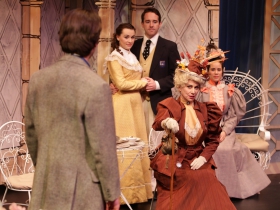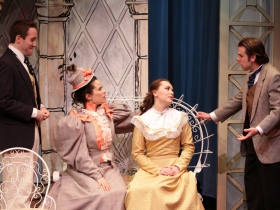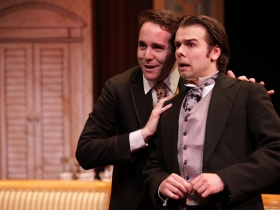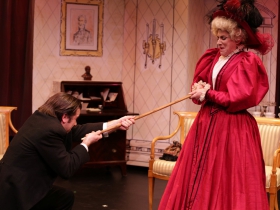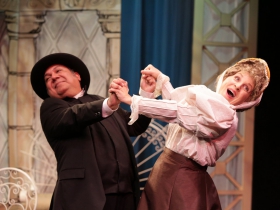‘Ernest in Love’ Is a Delight
Musical version of classic Wilde comedy is a revelation. Don’t miss it.
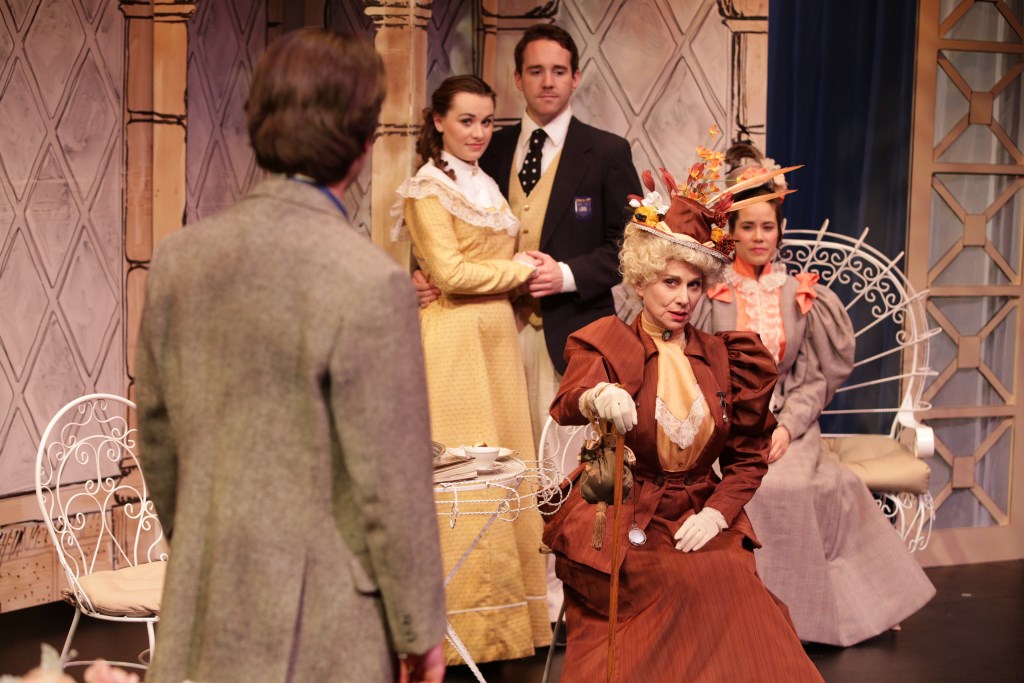
Zachary Thomas Woods (Jack), Peyton Oseth (Cecily), Doug Clemons (Algernon), Kristin Hammargren (Gwendolen), Angela Iannone (center-Lady Bracknell). Photo by Ryan Blomquist Photography.
Brain logic suggests nothing good can happen from adding musical comedy to the English language’s near perfection of style known as The Importance of Being Earnest.
Put such logic aside and embrace the marriage of giddiness known as Ernest in Love, the often overlooked 1960 off-Broadway musical that lives on in revivals. The show requires a special brand of technical care and needs the unabashed enthusiasm and showy big-note talents represented through May 15 in a collaboration of the In Tandem Theatre and the Milwaukee Opera Theatre.
The show is two things at once, not the same as the Oscar Wilde original and yet totally dependent on it.
Wilde always had a sardonic view of young lovers. Ernest in Love lays on top of that a romantic exuberance. Young gentlemen are snared by socially impossible courtships, mistaken identity, moral strictures and classic non-sequiturs. The musical’s method is more pronounced and compressed, yet the bon mots keep mounting. (Familiars will have fun guessing how much of the original dialog remains – tons — and how much is being echoed and riffed upon).
Ernest in Love simplifies the character elements – except for the steely eye and acid voice of a Milwaukee treasure, Angela Iannone. Her Lady Bracknell could be dropped into any Wilde production by any repertory ensemble in the world and still remain the biggest laugh-getter in the play. And when Iannone freezes the audience and Jack Worthing with “A Handbag Is Not a Proper Mother,” that number alone is worth the price of admission – quite remarkable that a patter song that only has meaning within the script will have the audience humming on the way out.
For most of the other parts, In Tandem has found striking talents – perhaps most memorable Peyton Oseth as the self-absorbed ingénue Cecily. But close behind are Kristin Hammargren as the socially superior Gwendolen and the dueling baritones of Zachary Thomas Woods as Jack (more manic from the start in the musical version) and Doug Clemons as the ever smirking Algernon.
Here is where the musical mainly departs from the original. It is a Technicolor variation. While many productions of the original spend fortunes on costumes and sets to re-create the Victorian times, In Tandem has spent its energies on colorful innovation. The unfolding scenic flats of Joe Brehl to suggest elegant rooms and gardens, the use of the servants as stagehands carting on antique furniture, the puffy outlines and practical employment of Kathy Smith’s costumes – none would fly along London’s West End but work perfectly here. As does the rhythmic sophistication of David Bonofiglio, the music director doubling as pianist and accompanied by flute and clarinet. The immediacy of these methods heightens the pleasure.
There are actually two songs in Ernest in Love that could have fit the era’s Top Ten list – “A Wicked Man,” which Oseth first performs and Clemons reprises, and “You Can’t Make Love,” the latter allowing the servants played by James Nathan and Katherine Duffy to mock the cautious sexual foreplay of the aristocratic set. But their duet also pinpoints the perils of musical comedy added to the Wilde style – the actors play it too broadly. Even unsophisticated newcomers to the theater – and I hope this production attracts many — may feel this one scene is hitting them on the head with sly double entendres they could have enjoyed without such billboarding.
The same tendency to exaggerate comic moments constantly affects David Flores as Rev. Dr. Chasuble and sometimes even the matronly object of his gleaming eye, Miss Prism — though in that role Carol Greif’s character acting instincts pull her through.
There is a patina of old-fashioned musical comedy – the actors a bit too loud, the jokes a bit too underlined to survive in a serious production of the original Wilde. But this, after all, is not that Earnest. It is a charm-filled Ernest where the courtship is emphasized with less of the original cynicism. The women circle and catfight with a romantic ease (probably not the intentions of Wilde, who once implied that Niagara Falls was the American bride’s second greatest disappointment). With Iannone the granted exception, this is a lighter musical variation that broadly picks out the high points.
But by golly it works. Director Jane Flieller exacts a crisp back and forth among the principals and has the singers to bring off the sense of operetta linked to high comedy. Its fine direction bolstered by James Zager’s detailed choreography. She errs in overplaying the mannerisms of the servants – among whom are her husband Chris Flieller, the company’s artistic director, who actually sets a style of restraint that the other servants should emulate.
The production is more than a successful marriage of Wilde and musical theater. It also mixes Equity and non-Equity performers to good effect. On the Actors Equity side are the male Fieller and particularly Iannone (who probably set the tone of exact intonation the others followed).
But on the other side are reminders of the Midwest’s strong and growing pool of performers, particularly in musical skills with a foundation in acting. Clemons has so much fun with Algernon’s mischievous side that the salesmanship weirdly fits as he sings while eating. As Jack, Woods hits every line too hard. But if this is a less modulated Jack than expected, it is a nimble Jack with great musical flair and an excitability about love that patrons come to share. Hammargren’s Gwendolen moves and sings well but this is the flirtatious role that even in musical comedy requires deeper acting finesse. The real find is Oseth as Cecily, who seems born to the mantle of this form of musical comedy.
The roots of this production are more intimacy than grandeur, which is ideal for this melding of Earnest and Ernest and for In Tandem’s Tenth Street Theatre, in the back of the famous red church on Wisconsin Avenue.
Dominique Paul Noth served for decades as film and drama critic, later senior editor for features at the Milwaukee Journal. You can find his blog here and here.
Ernest in Love Gallery
Review
-
Eating Burmese in Bay View
 Dec 13th, 2025 by Cari Taylor-Carlson
Dec 13th, 2025 by Cari Taylor-Carlson
-
Casablanca Is a Milwaukee Success
 Nov 30th, 2025 by Cari Taylor-Carlson
Nov 30th, 2025 by Cari Taylor-Carlson
-
Oh, Those Witty 18th Century Brits
 Nov 24th, 2025 by Dominique Paul Noth
Nov 24th, 2025 by Dominique Paul Noth
Theater
-
Oh, Those Witty 18th Century Brits
 Nov 24th, 2025 by Dominique Paul Noth
Nov 24th, 2025 by Dominique Paul Noth
-
Skylight’s Holiday Show Is Lots of Fun
 Nov 16th, 2025 by Dominique Paul Noth
Nov 16th, 2025 by Dominique Paul Noth
-
Rep’s ‘Come From Away’ Is a Triumph
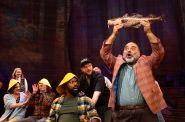 Nov 10th, 2025 by Dominique Paul Noth
Nov 10th, 2025 by Dominique Paul Noth

